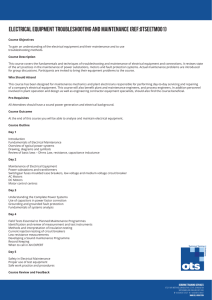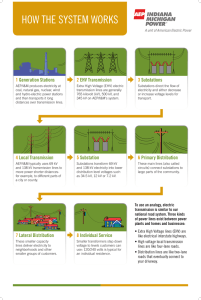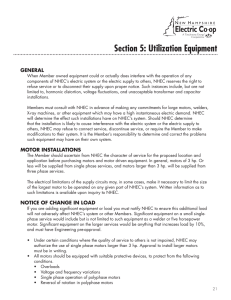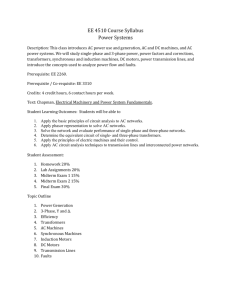engg electrical traction 2
advertisement
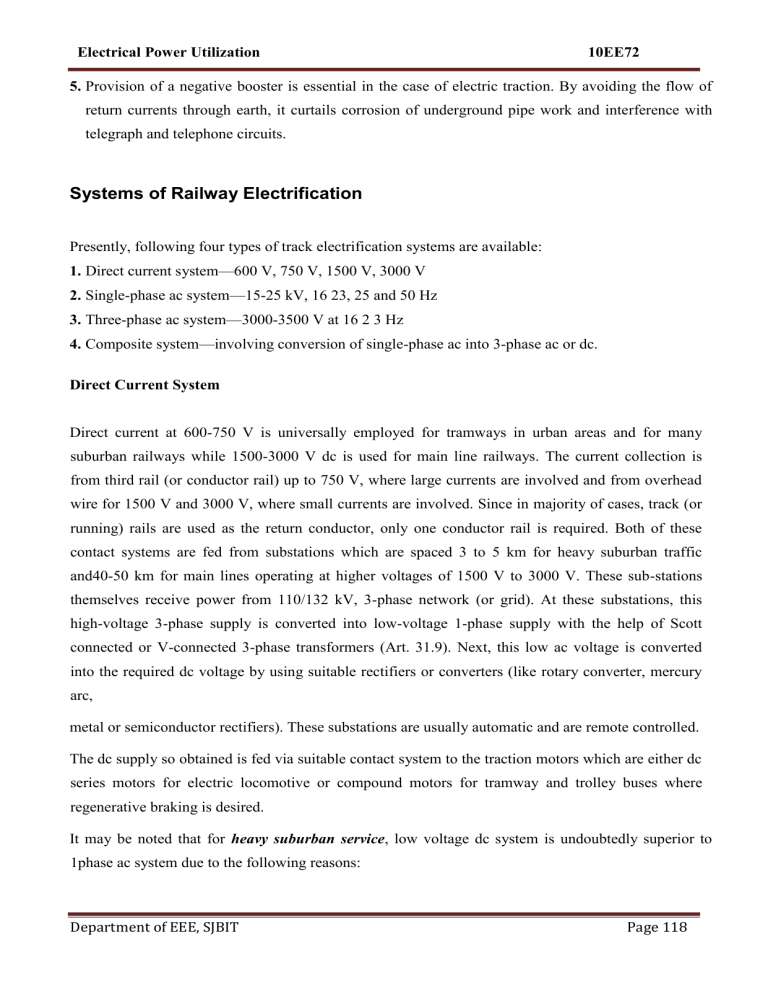
Electrical Power Utilization 10EE72 5. Provision of a negative booster is essential in the case of electric traction. By avoiding the flow of return currents through earth, it curtails corrosion of underground pipe work and interference with telegraph and telephone circuits. Systems of Railway Electrification Presently, following four types of track electrification systems are available: 1. Direct current system—600 V, 750 V, 1500 V, 3000 V 2. Single-phase ac system—15-25 kV, 16 23, 25 and 50 Hz 3. Three-phase ac system—3000-3500 V at 16 2 3 Hz 4. Composite system—involving conversion of single-phase ac into 3-phase ac or dc. Direct Current System Direct current at 600-750 V is universally employed for tramways in urban areas and for many suburban railways while 1500-3000 V dc is used for main line railways. The current collection is from third rail (or conductor rail) up to 750 V, where large currents are involved and from overhead wire for 1500 V and 3000 V, where small currents are involved. Since in majority of cases, track (or running) rails are used as the return conductor, only one conductor rail is required. Both of these contact systems are fed from substations which are spaced 3 to 5 km for heavy suburban traffic and40-50 km for main lines operating at higher voltages of 1500 V to 3000 V. These sub-stations themselves receive power from 110/132 kV, 3-phase network (or grid). At these substations, this high-voltage 3-phase supply is converted into low-voltage 1-phase supply with the help of Scott connected or V-connected 3-phase transformers (Art. 31.9). Next, this low ac voltage is converted into the required dc voltage by using suitable rectifiers or converters (like rotary converter, mercury arc, metal or semiconductor rectifiers). These substations are usually automatic and are remote controlled. The dc supply so obtained is fed via suitable contact system to the traction motors which are either dc series motors for electric locomotive or compound motors for tramway and trolley buses where regenerative braking is desired. It may be noted that for heavy suburban service, low voltage dc system is undoubtedly superior to 1phase ac system due to the following reasons: Department of EEE, SJBIT Page 118 Electrical Power Utilization 10EE72 1. dc motors are better suited for frequent and rapid acceleration of heavy trains than ac motors. 2. dc train equipment is lighter, less costly and more efficient than similar ac equipment. 3. when operating under similar service conditions, dc train consumes less energy than a 1-phase ac train. 4. the conductor rail for dc distribution system is less costly, both initially and in maintenance than the high-voltage overhead ac distribution system. 5. dc system causes no electrical interference with overhead communication lines. The only disadvantage of dc system is the necessity of locating ac/dc conversion sub-stations at relatively short distances apart. Single-Phase Low-frequency AC System In this system, ac voltages from 11 to 15 kV at 23 16 or 25 Hz are used. If supply is from a generating station exclusively meant for the traction system, there is no difficulty in getting the electric supply of 23 16 or 25 Hz. If, however, electric supply is taken from the high voltage transmission lines at 50 Hz, then in addition to step-down transformer, the substation is provided with a frequency converter. The frequency converter equipment consists of a 3-phase synchronous motor which drives a I-phase alternator having or 25 Hz frequency. The 15 kV 23 16 or 25 Hz supply is fed to the electric locomotors via a single over-head wire (running rail providing the return path). A step-down transformer carried by the locomotive reduces the 15-kV voltage to 300-400 V for feeding the ac series motors. Speed regulation of ac series motors is achieved by applying variable voltage from the tapped secondary of the above transformer. Low-frequency ac supply is used because apart from improving the commutation properties of ac motors, it increases their efficiency and power factor. Moreover, at low frequency, line reactance is less so that line impedance drop and hence line voltage drop is reduced. Because of this reduced line drop, it is feasible to space the substations 50 to 80 k Three-phase Low-frequency AC System Department of EEE, SJBIT Page 119 Electrical Power Utilization 10EE72 It uses 3-phase induction motors which work on a 3.3 kV, 23 16 Hz supply. Sub-stations receive power at a very high voltage from 3-phase transmission lines at the usual industrial frequency of 50 Hz. This high voltage is stepped down to 3.3 kV by transformers whereas frequency is reduced from 50 Hz to 23 16 Hz by frequency converters installed at the substations. Obviously, this system employs two overhead contact wires, the track rail forming the third phase (of course, this leads to insulation difficulties at the junctions). Induction motors used in the system are quite simple and robust and give trouble-free operation. They possess the merits of high efficiency and of operating as a generator when driven at speeds above the synchronous speed. Hence, they have the property of automatic regenerative braking during the descent on gradients. However, it may be noted that despite all its advantages, this system has not found much favor and has; in fact, become obsolete because of it‘s certain inherent limitations given below: 1. The overhead contact wire system becomes complicated at crossings and junctions. 2. constant-speed characteristics of induction motors are not suitable for traction work. 3. Induction motors have speed/torque characteristics similar to dc shunt motors. Hence, they are not suitable for parallel operation because, even with little difference in rotational speeds caused by unequal diameters of the wheels, motors will becomes loaded very unevenly. Composite System Such a system incorporates good points of two systems while ignoring their bad points. Two such composite systems presently in use are: 1. 1-phase to 3-phase system also called Kando system 2. 1-phase to dc system. Kando System In this system, single-phase 16-kV, 50 Hz supply from the sub-station is picked up by the locomotive through the single overhead contact wire. It is then converted into 3-phase ac supply at the same frequency by means of phase converter equipment carried on the locomotives. This 3-phase supply is then fed to the 3-phase induction motors. Department of EEE, SJBIT Page 120 Electrical Power Utilization 10EE72 As seen, the complicated overhead two contact wire arrangement of ordinary 3-phase system is replaced by a single wire system. By using silicon controlled rectifier as inverter, it is possible to get variable-frequency 3-phase supply at 1/2 to 9 Hz frequency. At this low frequency, 3-phase motors develop high starting torque without taking excessive current. In view of the above, Kando system is likely to be developed further. Single-phase AC to DC System This system combines the advantages of high-voltage ac distribution at industrial frequency with the dc series motors traction. It employs overhead 25-kV, 50-Hz supply which is stepped down by the transformer installed in the locomotive itself. The low-voltage ac supply is then converted into dc supply by the rectifier which is also carried on the locomotive. This dc supply is finally fed to dc series traction motor fitted between the wheels. The system of traction employing 25-kV, 50-Hz, 1phase ac supply has been adopted for all future track electrification in India. Advantages of 25-kV, 50-Hz AC System Advantages of this system of track electrification over other systems particularly the dc system are as under : 1. Light Overhead Catenary Since voltage is high (25 kV), line current for a given traction demand is less. Hence, crosssection of the overhead conductors is reduced. Since these small-sized conductors are light, supporting structures and foundations are also light and simple. Of course, high voltage needs higher insulation which increases the cost of overhead equipment (OHE) but the reduction in the size of conductors has an overriding effect. 2. Less Number of Substations Since in the 25-kV system, line current is less, line voltage drop which is mainly due to the resistance of the line is correspondingly less. It improves the voltage regulation of the line which fact makes larger spacing of 50-80 km between sub-stations possible as against 5-15 km with 1500 V dc system and 15-30 km with 3000 V dc sysem. Since the required number of substations along the track is considerably reduced, it leads to substantial saving in the capital expenditure on track electrification. 3. Flexibility in the Location of Substations Larger spacing of substations leads to greater flexibility in the selection of site for their proper location. These substations can be located near the national high-voltage grid which, in our country, Department of EEE, SJBIT Page 121 Electrical Power Utilization 10EE72 fortunately runs close to the main railway routes. The substations are fed from this grid thereby saving the railway administration lot of expenditure for erecting special transmission lines for their substations. On the other hand, in view of closer spacing of dc substations and their far away location, railway administration has to erect its own transmission lines for taking feed from the national grid to the substations which consequently increases the initial cost of electrification. 4. Simplicity of Substation Design In ac systems, the substations are simple in design and layout because they do not have to install and maintain rotary converters or rectifiers as in dc systems. They only consist of static transformers alongwith their associated switchgear and take their power directly from the high-voltage national grid running over the length and breadth of our country. Since such sub-stations are remotely controlled, they have few attending personnel or even may be unattended. 5. Lower Cost of Fixed Installations The cost of fixed installations is much less for 25 kV ac system as compared to dc system. In fact, cost is in ascending order for 25 kV ac, 3000 V dc and 1500 V dc systems. Consequently, traffic densities for which these systems are economical are also in the ascending order 6. Higher Coefficient of Adhesion The straight dc locomotive has a coefficient of adhesion of about 27% whereas its value for ac rectifier locomotive is nearly 45%. For this reason, a lighter ac locomotive can haul the same load as a heavier straight dc locomotive. Consequently, ac locomotives are capable of achieving higher speeds in coping with heavier traffic. 7. Higher Starting Efficiency An ac locomotive has higher starting efficiency than a straight dc locomotive. In dc locomotive supply voltage at starting is reduced by means of ohmic resistors but by on-load primary or secondary tap-changer in ac locomotives. Department of EEE, SJBIT Page 122 Electrical Power Utilization 10EE72 Block Diagram of an AC Locomotive The various components of an ac locomotive running on single-phase 25-kV, 50-Hz ac supply are numbered in Fig. 43.1. 1. OH contact wire 2. pantograph 3. circuit breakers 4. on-load tap-changers 5. transformer 6. rectifier 7. smoothing choke 8. dc traction motors. As seen, power at 25 kV is taken via a pantograph from the overhead contact wire and fed to the stepdown transformer in the locomotive. The low ac voltage so obtained is converted into pulsating dc voltage by means of the rectifier. The pulsations in the dc voltage are then removed by the smoothing choke beforeit is fed to dc series traction motors which are mounted between the wheels. The function of circuit breakers is to immediately disconnect the locomotive from the overhead supply in case of any fault in its electrical system. The on-load tap-changer is used to change the 1. voltage across the motors and hence regulate their speed. Department of EEE, SJBIT Page 123


